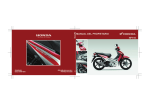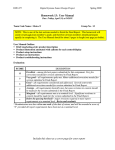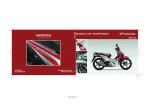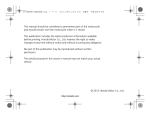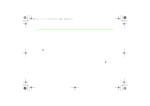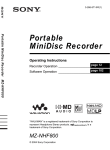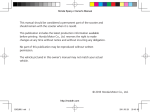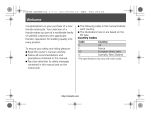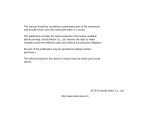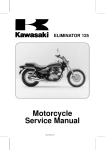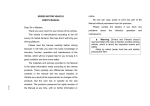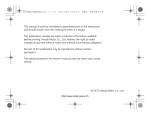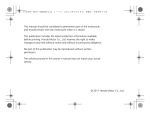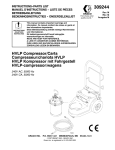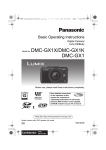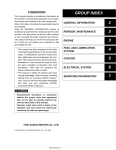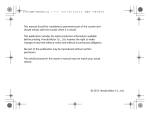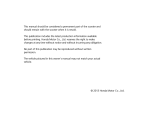Download Honda Wave 110i owners manual
Transcript
12 AFS110-32KWWH00.book 1 ページ 2011年10月26日 水曜日 午後5時22分 This manual should be considered a permanent part of the motorcycle and should remain with the motorcycle when it is resold. This publication includes the latest production information available before printing. Honda Motor Co., Ltd. reserves the right to make changes at any time without notice and without incurring any obligation. No part of this publication may be reproduced without written permission. The vehicle pictured in this owner’s manual may not match your actual vehicle. © 2011 Honda Motor Co., Ltd. http://mototh.com 12 AFS110-32KWWH00.book 2 ページ 2011年10月26日 水曜日 午後5時22分 Welcome Congratulations on your purchase of a new Honda motorcycle. Your selection of a Honda makes you part of a worldwide family of satisfied customers who appreciate Honda’s reputation for building quality into every product. To ensure your safety and riding pleasure: ● Read this owner’s manual carefully. ● Follow all recommendations and procedures contained in this manual. ● Pay close attention to safety messages contained in this manual and on the motorcycle. ● The following codes in this manual indicate each country. ● The illustrations here in are based on the ED type. Country Codes Code ED E F Country European direct sales UK France *The specifications may vary with each locale. http://mototh.com 12 AFS110-32KWWH00.book 3 ページ 2011年10月26日 水曜日 午後5時22分 A Few Words About Safety Your safety, and the safety of others, is very important. Operating this motorcycle safely is an important responsibility. To help you make informed decisions about safety, we have provided operating procedures and other information on safety labels and in this manual. This information alerts you to potential hazards that could hurt you or others. Of course, it is not practical or possible to warn you about all hazards associated with operating or maintaining a motorcycle. You must use your own good judgement. You will find important safety information in a variety of forms, including: ● Safety labels on the motorcycle ● Safety Messages preceded by a safety alert symbol and one of three signal words: DANGER, WARNING, or CAUTION. These signal words mean: 3 DANGER You WILL be KILLED or SERIOUSLY HURT if you don’t follow instructions. 3 WARNING You CAN be KILLED or SERIOUSLY HURT if you don’t follow instructions. 3 CAUTION You CAN be HURT if you don’t follow instructions. Other important information is provided under the following titles: NOTICE Information to help you avoid damage to your motorcycle, other property, or the environment. http://mototh.com 12 AFS110-32KWWH00.book 4 ページ 2011年10月26日 水曜日 午後5時22分 Contents http://mototh.com Motorcycle Safety P. 2 Operation Guide P. 18 Maintenance P. 35 Troubleshooting P. 78 Information P. 92 Specifications P. 103 Index P. 106 12 AFS110-32KWWH00.book 2 ページ 2011年10月26日 水曜日 午後5時22分 Motorcycle Safety This section contains important information for safe riding of your motorcycle. Please read this section carefully. Safety Guidelines .........................................P. 3 Image Labels.................................................P. 6 Safety Precautions .....................................P. 11 Riding Precautions .....................................P. 12 Accessories & Modifications......................P. 15 Loading .......................................................P. 16 http://mototh.com 12 AFS110-32KWWH00.book 3 ページ 2011年10月26日 水曜日 午後5時22分 Safety Guidelines Safety Guidelines Always Wear a Helmet It’s a proven fact: helmets and protective apparel significantly reduce the number and severity of head and other injuries. So always wear an approved motorcycle helmet and protective apparel. 2 P. 11 Before Riding Take Time to Learn & Practice Even if you have ridden other motorcycles, practice riding in a safe area to become familiar with how this motorcycle works and handles, and to become accustomed to the motorcycle’s size and weight. Ride Defensively Always pay attention to other vehicles around you, and do not assume that other drivers see you. Be prepared to stop quickly or perform an evasive maneuver. Make sure that you are physically fit, mentally focused and free of alcohol and drugs. Check http://mototh.com continued 3 Motorcycle Safety Follow these guidelines to enhance your safety: ● Perform all routine and regular inspections specified in this manual. ● Stop the engine and keep sparks and flame away before filling the fuel tank. ● Do not run the engine in enclosed or partly enclosed areas. Carbon monoxide in exhaust gases is toxic and can kill you. that you and your passenger are both wearing an approved motorcycle helmet and protective apparel. Instruct your passenger on holding onto the grab rail or your waist, leaning with you in turns, and keeping their feet on the footpegs, even when the motorcycle is stopped. 12 AFS110-32KWWH00.book 4 ページ 2011年10月26日 水曜日 午後5時22分 Safety Guidelines Make Yourself Easy to See Keep Your Honda in Safe Condition Motorcycle Safety Make yourself more visible, especially at night, by wearing bright reflective clothing, positioning yourself so other drivers can see you, signaling before turning or changing lanes, and using your horn when necessary. Ride within Your Limits Never ride beyond your personal abilities or faster than conditions warrant. Fatigue and inattention can impair your ability to use good judgement and ride safely. Don’t Drink and Ride Alcohol and riding don’t mix. Even one alcoholic drink can reduce your ability to respond to changing conditions, and your reaction time gets worse with every additional drink. Don’t drink and ride, and don’t let your friends drink and ride either. 4 It’s important to keep your motorcycle properly maintained and in safe riding condition. Inspect your motorcycle before every ride and perform all recommended maintenance. Never exceed load limits (2 P. 16), and do not modify your motorcycle or install accessories that would make your motorcycle unsafe (2 P. 15). If You are Involved in a Crash Personal safety is your first priority. If you or anyone else has been injured, take time to assess the severity of the injuries and whether it is safe to continue riding. Call for emergency assistance if needed. Also follow applicable laws and regulations if another person or vehicle is involved in the crash. If you decide to continue riding, first evaluate the condition of your motorcycle. If the engine is still running, turn it off. Inspect for fluid leaks, http://mototh.com 12 AFS110-32KWWH00.book 5 ページ 2011年10月26日 水曜日 午後5時22分 Safety Guidelines 3 WARNING Motorcycle Safety check the tightness of critical nuts and bolts, and check the handlebar, control levers, brakes, and wheels. Ride slowly and cautiously. Your motorcycle may have suffered damage that is not immediately apparent. Have your motorcycle thoroughly checked at a qualified service facility as soon as possible. Carbon monoxide gas is toxic. Breathing it can cause unconsciousness and even kill you. Avoid any areas or activities that expose you to carbon monoxide. Carbon Monoxide Hazard Exhaust contains poisonous carbon monoxide, a colourless, odorless gas. Breathing carbon monoxide can cause loss of consciousness and may lead to death. If you run the engine in confined or even partly enclosed area, the air you breathe could contain a dangerous amount of carbon monoxide. Never run your motorcycle inside a garage or other enclosure. http://mototh.com 5 12 AFS110-32KWWH00.book 6 ページ 2011年10月26日 水曜日 午後5時22分 Image Labels Image Labels Motorcycle Safety The following pages describe the label meanings. Some labels warn you of potential hazards that could cause serious injury. Others provide important safety information. Read this information carefully and don’t remove the labels. If a label comes off or becomes hard to read, contact your dealer for a replacement. There is a specific symbol on each label. The meanings of each symbol and label are as follows. 6 Read instructions contained in Owner’s Manual carefully. Read instructions contained in Shop Manual carefully. In the interest of safety, take the motorcycle to be serviced only by your dealer. DANGER (with RED background) You WILL be KILLED or SERIOUSLY HURT if you don’t follow instructions. WARNING (with ORANGE background) You CAN be KILLED or SERIOUSLY HURT if you don’t follow instructions. CAUTION (with YELLOW background) You CAN be HURT if you don’t follow instructions. http://mototh.com 12 AFS110-32KWWH00.book 7 ページ 2011年10月26日 水曜日 午後5時22分 Image Labels http://mototh.com continued 7 Motorcycle Safety BATTERY LABEL DANGER • Keep flame and spark away from the battery. Battery produce explosive gas that can cause explosion. • Wear the eye protection and rubber gloves when handling the battery, or you can get burned or lose your eyesight by the battery electrolyte. • Do not allow children and other people to touch a battery unless they understand proper handling and hazards of the battery very well. • Handle the battery electrolyte with extreme care as it contains dilute sulfuric acid. Contact with your skin or eyes can burn you or cause loss of your eyesight. • Read this manual carefully and understand it before handling the battery. Neglect of the instructions can cause personal injury and damage to the motorcycle. • Do not use a battery with the electrolyte at or below the lower level mark. It can explode causing serious injury. 12 AFS110-32KWWH00.book 8 ページ 2011年10月26日 水曜日 午後5時22分 Image Labels Motorcycle Safety ACCESSORIES AND LOADING WARNING LABEL WARNING ACCESSORIES AND LOADING • The safety stability and handling of this motorcycle may be affected by the addition of accessories and luggage. • Read carefully the instructions contained in user’s manual and installation guide before installing any accessory. • The total weight of accessories and luggage added to rider’s and passenger’s weight should not exceed 170 kg (375 lb), which is the maximum weight capacity. • The luggage weight must not exceed 9 kg (20 lb) under any circumstances. • The fitting of large fork-mounted or large handlebar mounted fairing is not recommended. 8 http://mototh.com 12 AFS110-32KWWH00.book 9 ページ 2011年10月26日 水曜日 午後5時22分 Image Labels Motorcycle Safety TYRE INFORMATION & DRIVE CHAIN LABEL Cold tyre pressure: [Driver only] Front 200 kPa (2.00 kgf/cm2, 29 psi) Rear 225 kPa (2.25 kgf/cm2, 33 psi) [Driver and passenger] Front 200 kPa (2.00 kgf/cm2, 29 psi) Rear 280 kPa (2.80 kgf/cm2, 41 psi) Tyre size: Front 70/90-17M/C 38P Rear 80/90-17M/C 50P Tyre brand: CHENG SHIN Front C-6016 Rear C-6016R Keep chain adjusted and lubricated. 20 to 30 mm (1.0 to 1.2 in) Freeplay http://mototh.com continued 9 12 AFS110-32KWWH00.book 10 ページ 2011年10月26日 水曜日 午後5時22分 Image Labels Motorcycle Safety SAFETY REMINDER LABEL For your protection, always wear helmet, protective apparel. FUEL LABEL Unleaded petrol only CARGO LIMIT LABEL Do not exceed 5.0 kg (11.0 lb). 5.0kg (11.0lb) 10 http://mototh.com 12 AFS110-32KWWH00.book 11 ページ 2011年10月26日 水曜日 午後5時22分 Safety Precautions ● Face shield with unobstructed field of vision Safety Precautions 3 WARNING handlebars and feet on the footpegs. ● Keep passenger’s hands onto the grab rail or your waist, passenger’s feet on the footpegs while riding. ● Always consider the safety of your passenger, as well as other drivers and riders. Not wearing a helmet increases the chance of serious injury or death in a crash. Make sure that you and any passenger always wear an approved helmet and protective apparel. Protective Apparel Make sure that you and any passenger are wearing an approved motorcycle helmet, eye protection, and high-visibility protective clothing. Ride defensively in response to weather and road conditions. ❙ Helmet Motorcycle Safety or other approved eye protection ● Ride cautiously and keep your hands on the ❙ Gloves Full-finger leather gloves with high abrasion resistance ❙ Boots or Riding Shoes Sturdy boots with non-slip soles and ankle protection Safety-standard certified, high-visibility, correct size for your head ● Must fit comfortably but securely, with the chin strap fastened ❙ Jacket and Trousers Protective, highly visible, long-sleeved jacket and durable trousers for riding (or a protective suit). http://mototh.com 11 12 AFS110-32KWWH00.book 12 ページ 2011年10月26日 水曜日 午後5時22分 Riding Precautions Riding Precautions Motorcycle Safety Running-in Period During the first 500 km (300 miles) of running, follow these guidelines to ensure your motorcycle’s future reliability and performance. ● Avoid full-throttle starts and rapid acceleration. ● Avoid hard braking and rapid down-shifts. ● Ride conservatively. u The tyres slip more easily on such surfaces and braking distances are longer. ● Avoid continuous braking. u Repeated braking, such as when descending long, steep slopes can seriously overheat the brakes, reducing their effectiveness. Use engine braking with intermittent use of the brakes to reduce speed. ● For full braking effectiveness, operate both the front and rear brakes together. Brakes Observe the following guidelines: ● Avoid excessively hard braking and downshifts. u Sudden braking can reduce the motorcycle’s stability. u Where possible, reduce speed before turning; otherwise you risk sliding out. ● Exercise caution on low traction surfaces. 12 http://mototh.com 12 AFS110-32KWWH00.book 13 ページ 2011年10月26日 水曜日 午後5時22分 Riding Precautions ❙ Engine Braking ❙ Wet or Rainy Conditions Road surfaces are slippery when wet, and wet brakes further reduce braking efficiency. Exercise extra caution when braking in wet conditions. If the brakes get wet, apply the brakes while riding at low speed to help them dry. Parking ● Park on a firm, level surface. ● If you must park on an incline or loose surface, park so that the motorcycle cannot move or fall over. ● Make sure that high-temperature parts cannot come into contact with flammable materials. ● Do not touch the engine, muffler, brakes and other high-temperature parts until they cool down. ● To reduce the likelihood of theft, always lock the handlebars and remove the key when leaving the motorcycle unattended. Use of an anti-theft device is also recommended. Motorcycle Safety Engine braking helps slow your motorcycle down when you release the throttle. For further slowing action, downshift to a lower gear. Use engine braking with intermittent use of the brakes to reduce speed when descending long, steep slopes. ❙ Parking with the Side Stand or Centre Stand 1. Stop the engine. 2. Use the side stand Push the side stand down. Slowly lean the motorcycle to the left until its weight rests on the side stand. http://mototh.com continued 13 12 AFS110-32KWWH00.book 14 ページ 2011年10月26日 水曜日 午後5時22分 Riding Precautions Motorcycle Safety Use the centre stand Let down the centre stand, stand on the left side of the motorcycle. Hold the left handle grip and the left grab rail. Press down on the tip of the stand with your right foot and, simultaneously, pull up and back. Left handle grip 3. Turn the handlebars fully to the left. u Turning the handlebars to the right reduces stability and may cause the motorcycle to fall. 4. Turn the ignition switch to the LOCK position and remove the key. 2 P. 25 Grab rail Refuelling and Fuel Guidelines Centre stand 14 Follow these guidelines to protect the engine and catalytic converter: ● Use only unleaded petrol. ● Use recommended octane number. Using lower octane petrol will result in decreased engine performance. ● Do not use fuels containing a high concentration of alcohol. 2 P. 95 ● Do not use stale or contaminated petrol or an oil/petrol mixture. ● Avoid getting dirt or water in the fuel tank. http://mototh.com 12 AFS110-32KWWH00.book 15 ページ 2011年10月26日 水曜日 午後5時22分 Accessories & Modifications 3 WARNING We strongly advise that you do not add any accessories that were not specifically designed for your motorcycle by Honda or make modifications to your motorcycle from its original design. Doing so can make it unsafe. Modifying your motorcycle may also void your warranty and make your motorcycle illegal to operate on public roads and highways. Before deciding to install accessories on your motorcycle be certain the modification is safe and legal. Improper accessories or modifications can cause a crash in which you can be seriously hurt or killed. Follow all instructions in this owner’s manual regarding accessories and modifications. Motorcycle Safety Accessories & Modifications Do not pull a trailer with, or attach a sidecar to, your motorcycle. Your motorcycle was not designed for these attachments, and their use can seriously impair your motorcycle’s handling. http://mototh.com 15 12 AFS110-32KWWH00.book 16 ページ 2011年10月26日 水曜日 午後5時22分 Loading Loading Motorcycle Safety 16 3 WARNING ● Carrying extra weight affects your motorcycle’s handling, braking and stability. Always ride at a safe speed for the load you are carrying. ● Avoid carrying an excessive load and keep within specified load limits. 2 Maximum weight capacity / Maximum luggage weight P. 103 ● Tie all luggage securely, evenly balanced and close to the centre of the motorcycle. ● Do not objects near the lights or the muffler. Overloading or improper loading can cause a crash and you can be seriously hurt or killed. Follow all load limits and other loading guidelines in this manual. http://mototh.com 12 AFS110-32KWWH00.book 17 ページ 2011年10月26日 水曜日 午後5時22分 Motorcycle Safety http://mototh.com 17 Operation Guide 12 AFS110-32KWWH00.book 18 ページ 2011年10月26日 水曜日 午後5時22分 Basic Operation Flow ❙ Pre-ride Inspection (P40) Carefully inspect your motorcycle to Operation Guide make sure that it is safe to ride. ❙ Acceleration Apply throttle gradually. Obey the speed limit. ❙ Starting the Engine (P26) Start and warm the engine. Avoid revving the engine. ❙ Starting the Motorcycle How to use basic features. • • • 18 Before pulling away, indicate Instruments (P22) your direction with the turn Switches (P24) signal switch, and check for Steering Lock (P25) oncoming traffic. http://mototh.com 12 AFS110-32KWWH00.book 19 ページ ❙ Braking 2011年10月26日 水曜日 午後5時22分 ❙ Parking (P13) Close the throttle and apply the Park on a firm level surface. u The brake lights will indicate that Use the stand, and lock the steering. you have applied the brakes. ❙ Stopping Operation Guide front and rear brake together. If pulling of the road, signal early enough to show traffic that you are pulling over, and pull over smoothly. ❙ Turning Corners ❙ Refuelling (P31) Do your braking before entering corners. Gradually reapply throttle when exiting turn. http://mototh.com 19 12 AFS110-32KWWH00.book 20 ページ 2011年10月26日 水曜日 午後5時22分 Parts Location Battery (P57) Operation Guide Fuse box (P91) Helmet holder (P33) Throttle grip (P58) Front brake fluid reservoir (P70) Front top cover (P52) Spark plug (P60) Kickstarter (P27) Engine oil drain bolt (P63) Engine oil fill cap/dipstick (P62) 20 http://mototh.com 12 AFS110-32KWWH00.book 21 ページ 2011年10月26日 水曜日 午後5時22分 Helmet holder (P33) Headlight case (P53) Document bag (P34) Tool kit (P34) Seat (P33) Fuel fill cap (P31) Operation Guide Centre compartment (P34) Seat lock (P33) Drive chain (P65) Side stand (P76) Crankcase breather Centre stand (P13) (P59) Shift lever (P29) http://mototh.com 21 12 AFS110-32KWWH00.book 22 ページ 2011年10月26日 水曜日 午後5時22分 Instruments Operation Guide Speedometer • This is shows your speed in kilometer per hour (km/h) and/or miles per hour (mph) depend on type. Gear range Shows proper speed range for each gear. Odometer • Total distance ridden. Fuel gauge Needle in the red mark, remaining fuel approximately 0.98 litres (0.259 US gal, 0.216 Imp gal) 22 http://mototh.com 12 AFS110-32KWWH00.book 23 ページ 2011年10月26日 水曜日 午後5時22分 Indicators (P80) Left turn signal indicator Gear position indicators Indicate 1st to 4th gear position. Operation Guide PGM-FI (Programmed Fuel Injection) malfunction indicator lamp (MIL) Comes on briefly when the ignition switch is turned on. If it comes on while engine is running: Right turn signal indicator Neutral indicator Comes on when the transmission is in Neutral. http://mototh.com High beam indicator 23 12 AFS110-32KWWH00.book 24 ページ 2011年10月26日 水曜日 午後5時22分 Switches Operation Guide Start button Headlight turns off when operating the starter motor. Turn signal switch u Pressing the switch turns the turn signal off. Horn button Headlight dimmer switch • : High beam • : Low beam 24 http://mototh.com 12 AFS110-32KWWH00.book 25 ページ 2011年10月26日 水曜日 午後5時22分 Ignition Switch Switches the electrical system on/off, locks the steering. ON Turns electrical system on for starting/riding. Turns engine off. LOCK Locks steering. Steering Lock Lock the steering when parking to help prevent theft. A U-shaped wheel lock or similar device is also recommended. !a !b Push ❙ Locking Operation Guide OFF u Key can be removed when in the OFF or LOCK position. !a Turn the handlebars all the way to the left or right. !b Push the key down, and turn the ignition switch to the LOCK position. u Jiggle the handlebars if the lock is difficult to engage. !c Remove the key. ❙ Unlocking Turn Ignition key Insert the key and turn the ignition switch to the OFF position. http://mototh.com 25 12 AFS110-32KWWH00.book 26 ページ 2011年10月26日 水曜日 午後5時22分 Starting the Engine Operation Guide 26 Start your engine using the following procedure, regardless of whether the engine is cold or warm. This motorcycle is equipped with a side stand ignition cut-off system. u If the side stand is down, the engine cannot be started. u If you lower the side stand with the engine running, it will automatically shut off unless the transmission is in neutral. Do not operate the kickstarter while the engine is running as engine damage could result. Do not apply excessive force on the kickstarter. Fold up the kickstarter after the kickstarter is returned to the pedal stop. Consult your dealer for advice if you plan to ride your motorcycle at an altitude above 2,500 m (8,000 feet). NOTICE • If the motorcycle is transported to a place 2,000 m (6,500 feet) higher or lower than the start point, you may not be able to achieve sufficient engine performance at the new altitude. Consult your dealer before transporting your motorcycle. http://mototh.com 12 AFS110-32KWWH00.book 27 ページ 2011年10月26日 水曜日 午後5時22分 !a Turn the ignition switch to the ON position. !c !a NOTICE • If the engine does not start within 5 seconds, turn the ignition OFF and wait 10 seconds before trying to start the engine again for recovery of battery voltage. • Extended fast idling and revving the engine can damage the engine, and the exhaust system. !c (Using the start button) Press the start button with the throttle completely closed. Release the start button as soon as the engine starts. (Using the Kickstarter) Lightly depress the kickstarter until resistance is felt. Then let the kickstarter return to the top of its stroke. With the throttle closed, operate the kickstarter. Kick from the top of the stroke through to the bottom with a rapid, continuous motion. http://mototh.com Operation Guide !b !b Make sure the transmission to Neutral ( N indicator comes on). continued 27 12 AFS110-32KWWH00.book 28 ページ 2011年10月26日 水曜日 午後5時22分 Starting the Engine (Continued) Operation Guide If you cannot start the engine: (Using the kickstater) !a With the throttle slightly open (about 3 mm), press the start button or operate the kickstarter. About 3 mm !a Turn the ignition switch to OFF position. ! bOpen the throttle fully and crank the engine several times with the kickstarter. ! cTurn the ignition switch to ON position. ! dFollow the normal starting procedure. If the engine starts with unstable idle, open the throttle slightly. If the engine does not start, wait for 10 seconds, then follow steps ! a-! d again ❙ If Engine Will Not Start (P79) If the engine does not start: (Using the start button) !a Open the throttle fully and press the start button for 5 seconds. ! bRepeat the normal starting procedure. ! cIf the engine starts, open the throttle slightly if idling is unstable. ! dIf the engine does not start, wait 10 seconds before trying steps ! a & ! b again. 28 http://mototh.com 12 AFS110-32KWWH00.book 29 ページ 2011年10月26日 水曜日 午後5時22分 Shifting Gears u Always return the throttle grip first before changing gear. u Operate lightly with the tips of your toes until the shift lever is pushed down. u Avoid changing gear needlessly and riding with your foot on the shift lever since this may damage the gear change mechanism and clutch mechanism. http://mototh.com Stopping Operation Guide Your motorcycle transmission has four forward gears. The gearshift operation differs when stopping and when moving. When stopping, change can be made from 4th to neutral directly with the 4-step rotary system. When moving, the forward 4-step return system is used. Change cannot be made from 4th to neutral directly. Moving continued 29 12 AFS110-32KWWH00.book 30 ページ 2011年10月26日 水曜日 午後5時22分 Shifting Gears (Continued) If you put the motorcycle in gear with the side stand down, the engine will shut off. Operation Guide Proper shifting can prevent damaging the engine and transmission. Upshifting The upper limit speed of each gear is shown in gear range. (P22) Upshift to a higher gear before exceeding the Upper limit speed. Upshifting at speeds higher than the upper limit speed can cause damage to the engine. 30 Downshifting Downshifting at speeds higher than those in the table below may over rev the engine and can cause damage to the engine and transmission. Follow the table below when downshifting the gears. Downshifting Acceptable Speed From 4th to 3rd 75 km/h or less From 3rd to 2nd 50 km/h or less From 2nd to 1st 30 km/h or less http://mototh.com 12 AFS110-32KWWH00.book 31 ページ 2011年10月26日 水曜日 午後5時22分 Refuelling Fuel type: Unleaded petrol only Fuel octane number: Your motorcycle is designed to use Research Octane Number (RON) 90 or higher. Tank capacity: 3.7 litres (0.98 US gal, 0.81 lmp gal) Filler neck Fuel fill cap Fuel level (max) ❙ Refuelling and Fuel Guidelines (P14) Arrow marks Operation Guide Fuel filler opening Opening the Fuel Fill Cap !a Open the seat. 2 P. 33 !b Turn the fuel fill cap counterclockwise until it stops and remove the cap. Do not fill with fuel above the filler neck. http://mototh.com continued 31 12 AFS110-32KWWH00.book 32 ページ 2011年10月26日 水曜日 午後5時22分 Refuelling (Continued) Closing the Fuel Fill Cap Operation Guide !a Install and tighten the fuel fill cap firmly by turning it clockwise. u Make sure that the arrow marks on the cap and fuel tank is aligned. !b Close the seat. 3 WARNING Petrol is highly flammable and explosive. You can be burned or seriously injured when handling fuel. • Stop the engine, and keep heat, sparks, and flame away. • Handle fuel only outdoors. • Wipe up spills immediately. 32 http://mototh.com 12 AFS110-32KWWH00.book 33 ページ 2011年10月26日 水曜日 午後5時22分 Storage Equipment u Use the helmet holders only when parked. Operation Guide Helmet holders The helmet holders are located under the seat. Ignition key 3 WARNING Seat lock Seat Open Insert the ignition key into the seat lock and turn it clockwise to unlock. Seat Close Close and push down on the rear of the seat until it locks. Make sure that the seat is locked securely to pull it up lightly. Riding with a helmet attached to the holder can interfere with the rear wheel or suspension and could cause a crash in which you can be seriously hurt or killed. Use the helmet holder only while parked. Do not ride with a helmet secured by the holder. http://mototh.com continued 33 12 AFS110-32KWWH00.book 34 ページ 2011年10月26日 水曜日 午後5時22分 Storage Equipment (Continued) Operation Guide Centre compartment Document bag Never exceed the maximum weight limit. Maximum Weight: 5.0 kg (11.0 lb) The document bag is in the document compartment in the reverse side of the seat. u Do not store any items that are flammable or susceptible to heat damage. Tool kit Document bag Document compartment Centre compartment Tool kit The tool kit is in the centre compartment. 34 http://mototh.com 12 AFS110-32KWWH00.book 35 ページ 2011年10月26日 水曜日 午後5時22分 Maintenance Please read “Importance of Maintenance” and “Maintenance Fundamentals” carefully before attempting any maintenance. Refer to “Specifications” for service data. Importance of Maintenance ..................... P. 36 Maintenance Schedule .............................. P. 37 Maintenance Fundamentals ..................... P. 40 Tool kit ....................................................... P. 51 Removing & Installing Body Components ...P. 52 Front Top Cover. .......................................... P. 52 Headlight Case . ........................................... P. 53 Clip. ............................................................. P. 56 Battery. ........................................................ P. 57 Throttle....................................................... P. 58 Crankcase Breather.................................... P. 59 Spark Plug .................................................. P. 60 Engine Oil ...................................................P. 62 Drive Chain .................................................P. 65 Brakes .........................................................P. 70 Clutch ..........................................................P. 75 Side Stand...................................................P. 76 Other Adjustments ....................................P. 77 Headlight Aim ...........................................P. 77 Brakelight Switch ......................................P. 77 http://mototh.com 12 AFS110-32KWWH00.book 36 ページ 2011年10月26日 水曜日 午後5時22分 Importance of Maintenance Importance of Maintenance Maintenance Safety Maintenance Keeping your motorcycle well-maintained is absolutely essential to your safety and to protect your investment, obtain maximum performance, avoid breakdowns, and reduce air pollution. Maintenance is the owner’s responsibility. Be sure to inspect your motorcycle before each ride, perform the periodic checks specified in the Maintenance Schedule. 2 P. 37 3 WARNING Improperly maintaining your motorcycle or failing to correct a problem before you ride can cause a crash in which you can be seriously hurt or killed. Always follow the inspection and maintenance recommendations and schedules in this owner’s manual. 36 Always read the maintenance instructions before you begin each task, and make sure that you have the tools, parts, and skills required. We cannot warn you of every conceivable hazard that can arise in performing maintenance. Only you can decide whether or not you should perform a given task. Follow these guidelines when performing maintenance. ● Stop the engine and remove the key. ● Park your motorcycle on a firm, level surface using the centre stand or a maintenance stand to provide support. ● Allow the engine, muffler, brakes, and other high-temperature parts to cool before servicing as you can get burned. ● Run the engine only when instructed, and do so in a well-ventilated area. http://mototh.com 12 AFS110-32KWWH00.book 37 ページ 2011年10月26日 水曜日 午後5時22分 Maintenance Schedule The maintenance schedule specifies the maintenance requirements necessary to ensure safe, dependable performance, and proper emission control. Honda recommends that your dealer should road test your motorcycle after each periodic maintenance is carried out. http://mototh.com Maintenance Maintenance work should be performed in accordance with Honda’s standards and specifications by properly trained and equipped technicians. Your dealer meets all of these requirements. Keep an accurate record of maintenance to help ensure that your motorcycle is properly maintained. Make sure that whomever performs the maintenance completes this record. All scheduled maintenance is considered a normal owner operating cost and will be charged for by your dealer. Retain all receipts. If you sell the motorcycle, these receipts should be transferred with the motorcycle to the new owner. continued 37 12 AFS110-32KWWH00.book 38 ページ 2011年10月26日 水曜日 午後5時22分 Maintenance Schedule Items Pre-ride Check 2 P. 40 × 1,000 km × 1,000 mi Odometer reading *1 1 4 8 0.6 2.5 5 I Fuel Line Throttle Operation Maintenance I I 12 7.5 I I I I Every 16,000 km (10,000 mi) R Air Cleaner *2 Annual Check Refer to page I – I 58 – Crankcase Breather *3 59 I R I I I I I R R R R Spark Plug Valve Clearance Engine Oil Regular Replace I 60 – R Engine Oil Strainer Screen 62 – Engine Oil Centrifugal Filter – I Engine Idle Speed I I I I – Maintenance Level : Intermediate. We recommend service by your dealer, unless you have the necessary tools and are mechanically skilled. Procedures are provided in an official Honda Shop Manual. : Technical. In the interest of safety, have your motorcycle serviced by your dealer. Maintenance Legend I : Inspect (clean, adjust, lubricate, or replace, if necessary) : Clean R : Replace : Lubricate 38 http://mototh.com 12 AFS110-32KWWH00.book 39 ページ 2011年10月26日 水曜日 午後5時22分 Maintenance Schedule Items Pre-ride Check 2 P. 40 × 1,000 km × 1,000 mi Odometer reading *1 1 4 8 0.6 2.5 5 12 7.5 Annual Check Regular Replace 2 Years Every 500 km (300 mi): I Refer to page Drive Chain I Brake Fluid *4 I I I I I Brake Shoes/Pads Wear I I I I I 71, 74 Brake System I 70 I I I 40 I I I I 77 Headlight Aim I I I I 77 I I I I 75 Side Stand I I I I 76 Suspension I I I I – I Clutch System I Nuts, Bolts, Fasteners I I I Steering Head Bearings I Notes: *1 : At higher odometer readings, repeat at the frequency interval established here. *2 : Service more frequently when riding in unusually wet or dusty areas. *3 : Service more frequently when riding in rain or at full throttle. *4 : Replacement requires mechanical skill. http://mototh.com I I – I I 47 I I – Maintenance I Brake Light Switch Wheels/Tyres I 65 39 12 AFS110-32KWWH00.book 40 ページ 2011年10月26日 水曜日 午後5時22分 Maintenance Fundamentals ● Pre-ride Inspection Maintenance 40 To ensure safety, it is your responsibility to perform a pre-ride inspection and make sure that any problem you find is corrected. A preride inspection is a must, not only for safety, but because having a breakdown, or even a flat tyre, can be a major inconvenience. Brakes - Check operation; Front: check brake fluid level 2 P. 70 and pads wear. 2 P. 71 Rear: check shoes wear 2 P. 74 and freeplay, adjust if necessary. 2 P. 72 ● Wheels and tyres - Check condition, air pressure and adjust if necessary. 2 P. 47 Check the following items before you get on your motorcycle: ● Throttle - Check for smooth opening and full closing in all steering positions. 2 P. 58 ● Engine oil level - Add engine oil if necessary. Check for leaks. 2 P. 62 ● Drive chain - Check condition and slack, adjust and lubricate if necessary. 2 P. 65 http://mototh.com 12 AFS110-32KWWH00.book 41 ページ 2011年10月26日 水曜日 午後5時22分 Maintenance Fundamentals Replacing Parts Always use Honda Genuine Parts or their equivalents to ensure reliability and safety. Colour label http://mototh.com Installing non-Honda parts may make your motorcycle unsafe and cause a crash in which you can be seriously hurt or killed. Always use Honda Genuine Parts or equivalents that have been designed and approved for your motorcycle. Maintenance When ordering coloured components, specify the model name, colour, and code mentioned on the colour label. The colour label is attached to the centre compartment. 2 P. 33 3 WARNING 41 12 AFS110-32KWWH00.book 42 ページ 2011年10月26日 水曜日 午後5時22分 Maintenance Fundamentals Battery Maintenance Your motorcycle has a maintenance-free type battery. You do not have to check the battery electrolyte level or add distilled water. Clean the battery terminals if they become dirty or corroded. Do not remove the battery cap seals. There is no need to remove the cap when charging. NOTICE Your battery is a maintenance-free type and can be permanently damaged if the cap strip is removed. This symbol on the battery means that this product must not be treated as household waste. NOTICE An improperly disposed of battery can be harmful to the environment and human health. Always confirm local regulations for battery disposal. 42 3 WARNING The battery gives off explosive hydrogen gas during normal operation. A spark or flame can cause the battery to explode with enough force to kill or seriously hurt you. Wear protective clothing and a face shield, or have a skilled mechanic do the battery servicing. ❙ Cleaning the Battery Terminals 1. Remove the battery. 2 P. 57 2. If the terminals are starting to corrode and are coated with a white substance, wash with warm water and wipe clean. http://mototh.com 12 AFS110-32KWWH00.book 43 ページ 2011年10月26日 水曜日 午後5時22分 Maintenance Fundamentals 3. If the terminals are heavily corroded, clean and polish the terminals with a wire brush or sandpaper. Wear safety glasses. Fuses ❙ Inspecting and Replacing Fuses 4. After cleaning, reinstall the battery. Turn off the ignition switch to remove and inspect fuses. If a fuse is blown, replace with a fuse of the same rating. For fuse ratings, see “Specifications.” 2 P. 105 Blown fuse The battery has a limited life span. Consult your dealer about when you should replace the battery. Always replace the battery with another maintenance-free battery of the same type. NOTICE Installing non-Honda electrical accessories can overload the electrical system, discharging the battery and possibly damaging the system. Maintenance Fuses protect the electrical circuits on your motorcycle. If something electrical on your motorcycle stops working, check for and replace any blown fuses. 2 P. 91 NOTICE Replacing a fuse with one that has a higher rating greatly increases the chance of damage to the electrical system. http://mototh.com continued 43 12 AFS110-32KWWH00.book 44 ページ 2011年10月26日 水曜日 午後5時22分 Maintenance Fundamentals If a fuse fails repeatedly, you likely have an electrical fault. Have your motorcycle inspected by your dealer. *1. Maintenance Engine Oil The JASO T 903 standard is an index for engine oils for 4-stroke motorcycle engines. There are two classes: MA and MB. For example, the following label shows the MA classification. Oil code Engine oil consumption varies and oil quality deteriorates according to riding conditions and time elapsed. Check the engine oil level regularly, and top off if necessary. Dirty oil or old oil should be changed as soon as possible. Oil classification *2. *3. ❙ Selecting the Engine Oil The SAE standard grades oils by their viscosity. The API classification specifies the quality and performance rating of engine oils. Use SG or higher oils, excluding oils marked as “Energy Conserving” on the circular API service symbol. For recommended engine oil, see “Specifications.” 2 P. 104 If you use non-Honda engine oil, check the label to make sure that the oil satisfies all of the following standards: ● JASO T 903 standard*1: MA ● SAE standard*2: 10W-30 ● API classification*3: SG or higher 44 http://mototh.com Not recommended Recommended 12 AFS110-32KWWH00.book 45 ページ 2011年10月26日 水曜日 午後5時22分 Maintenance Fundamentals Brake Fluid NOTICE Brake fluid can damage plastic and painted surfaces. Wipe up spills immediately and wash thoroughly. Also inspect the front sprocket and rear wheel sprocket. If either has worn or damaged teeth, have the sprocket replaced by your dealer. Recommended brake fluid: Honda DOT 3 or DOT 4 Brake Fluid or equivalent Drive Chain The drive chain must be inspected and lubricated regularly. Inspect the chain more frequently if you often ride on bad roads, ride at high speed, or ride with repeated fast acceleration. Normal (GOOD) Worn (REPLACE) Maintenance Do not add or replace brake fluid, except in an emergency. Use only fresh brake fluid from a sealed container. If you do add fluid, have the brake system serviced by your dealer as soon as possible. If the chain does not move smoothly, makes strange noises, has damaged rollers or loose pins or kinks, have the chain inspected by your dealer. Damaged (REPLACE) NOTICE User of a new chain with worn sprockets will cause rapid chain wear. http://mototh.com continued 45 12 AFS110-32KWWH00.book 46 ページ 2011年10月26日 水曜日 午後5時22分 Maintenance Fundamentals ❙ Cleaning and Lubricating Maintenance After inspecting the slack, clean the chain and sprockets while rotating the rear wheel using a dry cloth or a light brush. Saturate each chain link joint so that the lubricant penetrates between the link plates, pins, bushings, and rollers. Air Cleaner This motorcycle is equipped with a viscous type air cleaner element. Air blow cleaning or any other cleaning can degrade the viscous element performance and cause the intake of dust. Crankcase Breather Recommended lubricant: Pro Honda HP Chain Lube or SAE 80/90 gear oil Service more frequently when riding in rain, at full throttle, or after the motorcycle is washed or overturned. Service if the deposit level can be seen in the transparent section of the drain tube. Avoid getting lubricant on the brakes or tyres. Avoid applying excess chain lubricant to prevent spray onto your clothes and the motorcycle. 46 http://mototh.com 12 AFS110-32KWWH00.book 47 ページ 2011年10月26日 水曜日 午後5時22分 Maintenance Fundamentals ❙ Inspecting for Abnormal Wear Tyres (Inspecting/Replacing) ❙ Checking the Air Pressure ❙ Inspecting for Damage Maintenance Visually inspect your tyres and use an air pressure gauge to measure the air pressure at least once a month or any time you think the tyres look low. Always check air pressure when your tyres are cold. Inspect the tyres for signs of abnormal wear on the contact surface. Inspect the tyres for cuts, slits, or cracks that exposes fabric or cords, or nails or other foreign objects embedded in the side of the tyre or the tread. Also inspect for the bumps or bulges in the side walls of the tyres. http://mototh.com continued 47 12 AFS110-32KWWH00.book 48 ページ 2011年10月26日 水曜日 午後5時22分 Maintenance Fundamentals ❙ Inspecting Tread Depth Inspect the tread wear indicators. If they become visible, replace the tyres immediately. For safe riding, you should replace the tyres when the minimum tread depth is reached. Maintenance or TWI 3 WARNING Riding on tyres that are excessively worn or improperly inflated can cause a crash in which you can be seriously hurt or killed. Follow all instructions in this owner’s manual regarding tyre inflation and maintenance. Wear indicator location mark 48 http://mototh.com 12 AFS110-32KWWH00.book 49 ページ 2011年10月26日 水曜日 午後5時22分 Maintenance Fundamentals http://mototh.com 3 WARNING Installing improper tyres on your motorcycle can adversely affect handling and stability, and can cause a crash in which you can be seriously hurt or killed. Always use the size and type of tyres recommended in this owner’s manual. Maintenance Have your tyres replaced by your dealer. For recommended tyres and air pressure, see “Specifications.” 2 P. 104 Follow these guidelines whenever you replace tyres. ● Use the recommended tyres or equivalents of the same size, construction, speed rating, and load range. ● Remember to replace the inner tube whenever you replace a tyre. The old tube will probably be stretched, and it could fail if installed in a new tyre. ● Have the wheel balanced with Honda Genuine balance weights or equivalent after the tyre is installed. 49 12 AFS110-32KWWH00.book 50 ページ 2011年10月26日 水曜日 午後5時22分 Maintenance Fundamentals Air Cleaner Maintenance 50 This motorcycle is equipped with a viscous type air cleaner element. Air blow cleaning or any other cleaning can degrade the viscous element performance and cause the intake of dust. Do not perform the maintenance. Should be serviced by your dealer. http://mototh.com 12 AFS110-32KWWH00.book 51 ページ 2011年10月26日 水曜日 午後5時22分 Tool kit The tool kit is stored in the centre compartment. 2 P. 34 ● 10 × 14 mm Open end wrench Spark plug wrench ● Standard/Phillips screwdriver ● Screwdriver grip ● http://mototh.com Maintenance You can perform some roadside repairs, minor adjustments and parts replacement with the tools contained in the kit. 51 12 AFS110-32KWWH00.book 52 ページ 2011年10月26日 水曜日 午後5時22分 Removing & Installing Body Components ❙ Removal Front Top Cover The front top cover must be removed for front turn signal bulbs replacement. Maintenance Screws A Screws B ❙ Installation Install the parts in the reverse order of removal. Clips 52 Screws C Connectors 1. Remove the clips. 2 P. 56 2. Remove the screws A, screws B and screws C. 3. Remove the front top cover, then disconnect the connectors. Front top cover Screws C http://mototh.com 12 AFS110-32KWWH00.book 53 ページ 2011年10月26日 水曜日 午後5時22分 Removing & Installing Body Components u Headlight Case ❙ Removal Headlight Case Rearview mirrors Rubber dust covers Lock nut 1. Pull up the rubber dust covers. 2. Loosen the lock nuts by turning clockwise. 3. Loosen the rearview mirrors and remove them by turning them clockwise until they will no longer turn. 4. Loosen the mirror adapters and remove them. Maintenance The headlight case must be removed for headlight bulb and position light bulbs replacement. Lock nut Mirror adapter Mirror adapter http://mototh.com continued 53 12 AFS110-32KWWH00.book 54 ページ 2011年10月26日 水曜日 午後5時22分 Removing & Installing Body Components u Headlight Case Handle top cover Screw A Bolt Headlight case Boss A Rear handle cover Maintenance Screws B Boss A Screw A Screws A 5. Remove the screws A. 6. Remove the handle top cover. Connector Screws C 7. Remove the screws B, screws C and bolt. 8. Release the bosses A by pressing the rear handle cover. 9. Remove the headlight case, then disconnect the connector. 54 http://mototh.com 12 AFS110-32KWWH00.book 55 ページ 2011年10月26日 水曜日 午後5時22分 Removing & Installing Body Components u Headlight Case ❙ Installation Maintenance Install the parts in the reverse order of removal. u Make sure the tabs and boss B on the headlight case are settled proper position of the slots and grommet on the headlight case. u To install the rearview mirrors. 1. Install the mirror adapters. 2. Install the rearview mirrors by turning counterclockwise until they will no longer turn. 3. Loosen the rearview mirrors approximately 2 turns. 4. Adjust the rearview mirrors. 5. Tighten the lock nuts and install the rubber dust covers. Boss B Tabs Grommet Slots http://mototh.com 55 12 AFS110-32KWWH00.book 56 ページ 2011年10月26日 水曜日 午後5時22分 Removing & Installing Body Components u Clip ❙ Installation Clip The clip must be removed to remove the font top cover. Maintenance ❙ Removal 1. Press down on the centre pin to release the lock. 2. Pull the clip out of the hole. !a 1. Slightly open the retaining pawls and then push them out. 2. Insert the clip into the hole. 3. Lightly press down on the centre pin to lock the clip. !a !b !b 56 http://mototh.com !c 12 AFS110-32KWWH00.book 57 ページ 2011年10月26日 水曜日 午後5時22分 Removing & Installing Body Components u Battery ❙ Removal Battery Battery cover Negative terminal Battery Maintenance Positive terminal Screw Make sure the ignition switch is off. 1. Open the seat. 2 P. 33 2. Remove the battery cover by removing the screw. 3. Disconnect the negative - terminal from the battery. 4. Disconnect the positive + terminal from the battery. 5. Remove the battery taking care not to drop the terminal nuts. ❙ Installation Install the parts in the reverse order of removal. Always connect the positive + terminal first. Make sure that bolts and nuts are tight. For proper handling of the battery, see “Maintenance Fundamentals.” 2 P. 42 Battery Goes Dead 2 P. 86 http://mototh.com 57 12 AFS110-32KWWH00.book 58 ページ 2011年10月26日 水曜日 午後5時22分 Throttle Checking the Throttle Maintenance With the engine off, check that the throttle rotates smoothly from fully closed to fully open in all steering positions and throttle freeplay is correct. If the throttle does not move smoothly, close automatically, or if the cable is damaged, have the cable inspected by your dealer. Freeplay at the throttle grip flange: 2 to 6 mm (0.1 to 0.2 in). Freeplay Flange 58 http://mototh.com 12 AFS110-32KWWH00.book 59 ページ 2011年10月26日 水曜日 午後5時22分 Crankcase Breather Maintenance 1. Place a drain pan under the crankcase breather tube. 2. Remove the crankcase breather tube and drain deposits. 3. Reinstall the crankcase breather tube. Crankcase breather http://mototh.com 59 12 AFS110-32KWWH00.book 60 ページ 2011年10月26日 水曜日 午後5時22分 Spark Plug Checking Spark Plug Spark plug cap For the recommended spark plug, see “Specifications.” 2 P. 104 Maintenance Use only the recommended type of spark plug in the recommended heat range. NOTICE Using spark plugs with an improper heat range can cause engine damage. 1. Disconnect the spark plug cap. 2. Clean any dirt from around the spark plug base. 3. Remove the spark plug using the spark plug wrench provided in the tool kit. 60 4. Inspect the electrodes and centre porcelain for deposits, erosion or carbon fouling. u If the erosion or deposit is heavy, replace the plug. u Clean a carbon or wet-fouled plug with a plug cleaner, otherwise use a wire brush. http://mototh.com 12 AFS110-32KWWH00.book 61 ページ 2011年10月26日 水曜日 午後5時22分 Spark Plug u Checking Spark Plug 5. Check the spark plug gap using a wiretype feeler gauge. u If adjustment is necessary, bend the side electrode carefully. Side electrode Maintenance The gap should be: 0.80 to 0.90 mm (0.031 to 0.035 in) 8. Tighten the spark plug: ● If the old plug is good: 1/6 turn after it seats ● If installing a new plug, tighten it twice to prevent loosening: a) First, tighten the plug: 1/4 turn after it seats. b) Then loosen the plug. c) Next, tighten the plug again: 1/6 turn after it seats NOTICE Improperly tightened spark plugs can damage the engine. If a plug is too lose, a piston may be damaged. If a plug is too tight, the threads may be damaged. Spark plug gap 6. Make sure the plug washer is in good condition. 7. With the plug washer attached, thread the spark plug in by hand to prevent cross-threading. 9. Reinstall the spark plug cap. Take care avoid pinching any cables or wires. http://mototh.com 61 12 AFS110-32KWWH00.book 62 ページ 2011年10月26日 水曜日 午後5時22分 Engine Oil Checking the Engine Oil Maintenance 62 1. Park your motorcycle on its centre stand on a firm, level surface. 2. If the engine is cold, idle the engine for 3 to 5 minutes. 3. Turn the ignition switch off, stop the engine and wait 2 to 3 minutes. 4. Remove the oil fill cap/dipstick, wipe it clean. 5. Insert the oil fill cap/dipstick until it seats, but don’t screw it in. Check that the oil level is between the upper and lower level marks in the oil fill cap/dipstick. 6. Securely install the oil fill cap/dipstick. http://mototh.com Upper level Lower level Oil fill cap/dipstick 12 AFS110-32KWWH00.book 63 ページ 2011年10月26日 水曜日 午後5時22分 Engine Oil u Adding Engine Oil Adding Engine Oil If the engine oil is below or near the lower level mark, add the recommended engine oil. 1. Add the recommended oil until it reaches the upper level mark. u Place your motorcycle on its centre stand on a firm, level surface when check the oil level. u Do not overfill above the upper level mark. u Make sure no foreign objects enter the oil filler opening. u Wipe up any spills immediately. 2. Securely reinstall the oil fill cap/dipstick. Changing Engine Oil Changing the oil requires special tools. We recommend that you have your motorcycle serviced by your dealer. 1. Park your motorcycle on its centre stand on a firm, level surface. 2. If the engine is cold, idle the engine for 3 to 5 minutes. Maintenance 2 P. 44 For the recommended oil and oil selection guidelines, see “Maintenance Fundamentals.” 2 P. 44 NOTICE Overfilling with oil or operating with insufficient oil can cause damage to your engine. Do not mix different brands and grades of oil. They may affect lubrication and clutch operation. http://mototh.com continued 63 12 AFS110-32KWWH00.book 64 ページ 2011年10月26日 水曜日 午後5時22分 Engine Oil u Changing Engine Oil Maintenance 3. Turn the ignition switch off, stop the engine and wait for 2 to 3 minutes. 4. Place a drain pan under the drain bolt. 5. Remove the oil fill cap/dipstick, drain bolt, and sealing washer to drain the oil. u Discard the oil at an approved recycling centre. 6. Install a new sealing washer onto the drain bolt. 7. Install the drain bolt and tighten. Torque: 24 N·m (2.4 kgf·m, 18 lbf·ft) 8. Fill the crankcase with the recommended oil (2 P. 44) and install the oil fill cap/ dipstick. Required oil When changing oil: 0.8 litres (0.8 US qt, 0.7 Imp qt) 9. Check the oil level. 2 P. 62 10. Check that there are no oil leaks. Drain bolt Sealing washer 64 http://mototh.com 12 AFS110-32KWWH00.book 65 ページ 2011年10月26日 水曜日 午後5時22分 Drive Chain Drive chain slack: 20 to 30 mm (0.8 to 1.2 in) Check the drive chain slack at several points along the chain. If the slack is not constant at all points, some links may be kinked and binding. Have the chain inspected by your dealer. u Do not ride your motorcycle if the slack exceeds 50 mm (2.0 in). 1. Place your motorcycle on the centre stand on a level surface. 2. Stop the engine place the gear in Neutral. 3. Check the slack in the lower half of the drive chain midway between the sprockets. Move the drive chain up and down with your finger. Maintenance Inspecting the Drive Chain Slack 4. Rotate the rear wheel and check that the chain moves smoothly. 5. Inspect the sprockets. 2 P. 45 6. Clean and lubricate the drive chain. 2 P. 46 http://mototh.com 65 12 AFS110-32KWWH00.book 66 ページ 2011年10月26日 水曜日 午後5時22分 Drive Chain u Adjusting the Drive Chain Slack Adjusting the Drive Chain Slack Maintenance Adjusting the chain requires special tools. Have the drive chain slack adjusted by your dealer. 1. Place your motorcycle on the centre stand on a level surface. 2. Stop the engine place the gear in Neutral. 3. Loosen the rear axle nut. 4. Loosen the lock nuts on both sides of the drive chain adjusters. Lock nut Drive chain adjuster Scale graduations Adjusting nut Rear axle nut Scale graduations Drive chain adjuster 66 http://mototh.com Lock nut Adjusting nut 12 AFS110-32KWWH00.book 67 ページ 2011年10月26日 水曜日 午後5時22分 Drive Chain u Adjusting the Drive Chain Slack 7. Tighten the rear axle nut. Torque: 59 N·m (6.0 kgf·m, 44 lbf·ft) 8. Hold the adjusting nuts and tighten the lock nuts. 9. Recheck drive chain slack. 10. Rear brake pedal freeplay is affected when repositioning the rear wheel to adjust drive chain slack. Check rear brake pedal freeplay and adjust as necessary. Maintenance 5. Turn both adjusting nuts an equal number of turns until the correct drive chain slack is obtained. Turn the adjusting nuts clockwise to tighten the chain. Turn the adjusting nuts counterclockwise and push the rear wheel toward the front to provide more slack. Adjust the slack at a point midway between the front sprocket and the rear wheel sprocket. Check the drive chain slack. 2 P. 65 6. Check rear axle alignment by making sure the end of the drive chain adjuster aligns with the scale graduations on both sides of the swingarm. Both marks should correspond. If the axle is misaligned, turn the right or left adjusting bolt until the marks are aligned and recheck chain slack. 2 P. 72 If a torque wrench was not used for installation, see your dealer as soon as possible to verify proper assembly. Improper assembly may lead to loss of braking capacity. http://mototh.com continued 67 12 AFS110-32KWWH00.book 68 ページ 2011年10月26日 水曜日 午後5時22分 Drive Chain u Adjusting the Drive Chain Slack ❙ Checking the Drive Chain Wear Maintenance If the drive chain slack is excessive when the rear axle is moved to the furthest limit of adjustment, the drive chain is worn and must be replaced. Replacement drive chain: DID420AD-104RB KMC420JB-104 If necessary have the drive chain replaced by your dealer. ❙ Removal and Cleaning the Drive Chain When the drive chain becomes dirty, it should be removed and cleaned prior to lubrication. 1. With the engine off, carefully remove the master link retaining clip with a pair of pliers. Do not bend or twist the clip. Remove the master link. Remove the drive chain from the motorcycle. Master link retaining clip 68 http://mototh.com 12 AFS110-32KWWH00.book 69 ページ 2011年10月26日 水曜日 午後5時22分 Drive Chain u Adjusting the Drive Chain Slack 4. Install the drive chain. Pass the chain over the sprockets and join the ends of the chain with the master link. The master link is the most critical part affecting the security of the drive chain. Master links are reusable, if they remain in excellent condition, but it is recommended that a new master link retaining clip be installed whenever the drive chain is reassembled. Install the master link retaining clip so that the closed end of the clip will face the direction of forward wheel rotation. 5. Adjust the drive chain slack. 2 P. 66 http://mototh.com Maintenance 2. Clean the drive chain in high flash-point solvent and allow it to dry. Inspect the drive chain for possible wear or damage. Replace any chain that has damaged rollers, loose fitting links, or otherwise appears unserviceable. 3. Lubricate the drive chain. 2 P. 46 69 12 AFS110-32KWWH00.book 70 ページ 2011年10月26日 水曜日 午後5時22分 Brakes Checking Brake Fluid Front brake fluid reservoir Maintenance This motorcycle has a hydraulic front disc brake. As the brake pads wear, brake fluid level drops. 1. Place your motorcycle in an upright position on a firm, level surface. 2. Check that the brake fluid reservoir is horizontal and that the fluid level is above the LOWER level mark. If the brake fluid level in reservoir is below the lower level mark or the brake lever freeplay becomes excessive, inspect the brake pads for wear. If the brake pads are not worn, you most likely have a leak. Have your motorcycle inspected by your dealer. 70 http://mototh.com LOWER level mark 12 AFS110-32KWWH00.book 71 ページ 2011年10月26日 水曜日 午後5時22分 Brakes u Inspecting the Brake Pads Inspecting the Brake Pads Brake pad Disc Brake pad If necessary have the pads replaced by your dealer. Always replace both left and right brake pads at the same time. Maintenance Check the condition of the brake pad groove wear indicators. The pads need to be replaced if a brake pad is worn to the wear indicator. Inspect the brake pads from below the brake caliper. Wear indicator http://mototh.com 71 12 AFS110-32KWWH00.book 72 ページ 2011年10月26日 水曜日 午後5時22分 Brakes u Inspecting the Rear Brake Pedal Freeplay Maintenance Inspecting the Rear Brake Pedal Freeplay Adjusting the Rear Brake Pedal Freeplay 1. Place the motorcycle on its centre stand. 2. Measure the distance of the rear brake pedal before the starts to take hold. Make sure the cut-out on the adjusting nut is seated on the brake arm pin when adjusting the freeplay. Adjusting nut Freeplay at the tip of the brake pedal: 20 to 30 mm (0.8 to 1.2 in) Brake arm pin Rear brake pedal If proper adjustment cannot be obtained by this method, see your dealer. Freeplay 72 http://mototh.com 12 AFS110-32KWWH00.book 73 ページ 2011年10月26日 水曜日 午後5時22分 Brakes u Adjusting the Rear Brake Pedal Freeplay 1. Adjust by turning the rear brake adjusting nut a half-turn at a time. Brake arm Decrease freeplay Adjusting nut Brake arm pin Brake arm pin Increase freeplay 2. Apply the brake several times and check for free wheel rotation after the brake pedal is released. 3. Push the brake arm to confirm that there is a gap between the rear brake adjusting nut and brake arm pin. Adjusting nut Maintenance Push Gap After adjustment, confirm the freeplay of the brake pedal. NOTICE Do not turn the adjuster beyond its natural limits. Make sure the brakerod, brake arm spring and fastener are in good condition. http://mototh.com 73 12 AFS110-32KWWH00.book 74 ページ 2011年10月26日 水曜日 午後5時22分 Brakes u Inspecting the Brake Shoe Wear Inspecting the Brake Shoe Wear Maintenance The rear brake are equipped with a brake wear indicator. Brake panel Arrow When the brake is applied, an arrow attached to the brake arm moves toward a reference mark on the brake panel. If the arrow aligns with the reference mark on full application of the brake, the brake shoes must be replaced. See your dealer for this service. When the brake service is necessary, see your dealer. Use only Honda Genuine Parts or its equivalent. Reference mark Brake arm 74 http://mototh.com 12 AFS110-32KWWH00.book 75 ページ 2011年10月26日 水曜日 午後5時22分 Clutch Checking the Clutch System Adjuster Lock nut Maintenance 1. Loosen the lock nut. 2. Turn the clutch adjuster clockwise one turn; do not turn excessively. 3. Slowly turn the adjuster counterclockwise until a slight resistance is felt. From this position, turn the adjuster clockwise 1/8 turn, and tighten the lock nut. 4. After adjustment, test ride the motorcycle to be certain the clutch operates properly. The engine should start easily with the kicickstarter without the clutch slipping. When shifting gears, the clutch operation should be smooth and light, especially when shifting into neutral. http://mototh.com 75 12 AFS110-32KWWH00.book 76 ページ 2011年10月26日 水曜日 午後5時22分 Side Stand Maintenance 4. Sit on the motorcycle, shift the transmission in Neutral, and raise the side stand. 5. Start the engine, and shift the transmission into gear. 6. Lower the side stand all the way. The engine should stop as you lower the side stand. If the engine doesn’t stop, have your motorcycle inspected by your dealer. Side stand spring 1. Park your motorcycle on its centre stand on a firm, level surface. 2. Check that the side stand operates smoothly. If the side stand is stiff or squeaky, clean the pivot area and lubricate the pivot bolt with clean grease. 3. Check the spring for damage or loss of tension. 76 http://mototh.com 12 AFS110-32KWWH00.book 77 ページ 2011年10月26日 水曜日 午後5時22分 Other Adjustments Adjusting the Headlight Aim Check the operation of the brakelight switch. Turn the adjusting nut in the direction A if the switch operates too late, or turn the nut in the direction B if the switch operates too soon. Headlight Maintenance You can adjust vertical aim of the headlight for proper alignment. Loosen the adjusting bolt and move the headlight up or down as necessary. Tighten the adjusting bolt after adjustment. Obey local laws and regulations. Adjusting the Brakelight Switch Brakelight switch Adjusting bolt Up Down Adjusting nut http://mototh.com 77 12 AFS110-32KWWH00.book 78 ページ 2011年10月26日 水曜日 午後5時22分 Troubleshooting Engine Will Not Start .................................P. 79 Warning Indicator On or Flashing.............P. 80 PGM-FI (Programmed Fuel Injection) Malfunction Indicator Lamp (MIL) ............P. 80 Tyre Puncture .............................................P. 81 Tube Repair and Replacement ...................P. 81 Electrical Trouble........................................P. 86 Battery Goes Dead.....................................P. 86 Burned-out Light Bulb ...............................P. 86 Blown Fuse................................................P. 91 http://mototh.com 12 AFS110-32KWWH00.book 79 ページ 2011年10月26日 水曜日 午後5時22分 Engine Will Not Start ❙ Starter Motor Operates But Engine Does Not Start Check the following items: ● Check for a blown fuse 2 P. 91 ● Check for a loose battery connection or battery terminal corrosion 2 P. 42 ● Check the condition of the battery 2 P. 86 If the problem continues, have your motorcycle inspected by your dealer. http://mototh.com Troubleshooting Check the following items: ● Check the correct engine starting sequence 2 P. 26 ● Check that there is petrol in the fuel tank ● Check if the PGM-FI malfunction indicator lamp (MIL) is ON u If the indicator light is ON, contact your dealer as soon as possible. ❙ Starter Motor Does Not Operate 79 12 AFS110-32KWWH00.book 80 ページ 2011年10月26日 水曜日 午後5時22分 Warning Indicator On or Flashing PGM-FI (Programmed Fuel Injection) Malfunction Indicator Lamp (MIL) Troubleshooting 80 If the indicator comes ON while riding, you may have a serious problem with the PGM-FI system. Reduce speed and have your motorcycle inspected by your dealer as soon as possible. http://mototh.com 12 AFS110-32KWWH00.book 81 ページ 2011年10月26日 水曜日 午後5時22分 Tyre Puncture Repairing a puncture or removing a wheel requires special tools and technical expertise. We recommend you have this type of service performed by your dealer. After an emergency repair, always have the tyre inspected/replaced by your dealer. 3 WARNING Tube Repair and Replacement If a tube is punctured or damaged, you should replace it as soon as possible. A tube that is repaired may not have the same reliability as a new one, and it may fail while you are riding. If you need to make a temporary repair by patching a tube or using an aerosol sealant, ride cautiously at reduced speed and have the tube replaced before you ride again. Anytime a tube is replaced, the tyre should be carefully inspected as described. If you must ride with a temporary tyre or tube repair, ride slowly and carefully and do not exceed 50 km/h (30 mph) until the tyre and tube is replaced. Troubleshooting Riding your motorcycle with a temporary tyre or tube repair can be risky. If the temporary repair fails, you can crash and be seriously injured or killed. Removing Wheels Follow these procedures if you need to remove a wheel in order to repair a puncture. http://mototh.com continued 81 12 AFS110-32KWWH00.book 82 ページ 2011年10月26日 水曜日 午後5時22分 Tyre Puncture u Removing Wheels ❙ Front Wheel Front axle nut cap Troubleshooting Removal 1. Park your motorcycle on its centre stand on a firm, level surface. 2. Raise the front wheel off the ground by placing a support block under the engine. 3. Remove the speedometer cable by pushing the tab. 4. Remove the front axle nut cap. 5. Remove the front axle nut. 6. Remove the front axle shaft, front wheel and side collar. u Do not pull the brake lever while the wheel is removed. u Take care to prevent the brake caliper from scratching the wheel during removal. u Avoid getting grease, oil, or dirt on the disc or pad surface. Front axle nut Tab Speedometer cable Front axle shaft 82 http://mototh.com 12 AFS110-32KWWH00.book 83 ページ 2011年10月26日 水曜日 午後5時22分 Tyre Puncture u Removing Wheels Torque: 59 N·m (6.0 kgf·m, 44 lbf·ft) 5. Install the speedometer cable securely. 6. Install the front axle nut cap. Speedometer gear box Slot Troubleshooting Installation 1. Install the side collar into the right side wheel hub. 2. Position the wheel between the fork legs and insert the front axle shaft from the right side, through the right fork leg and wheel hub. 3. Make sure that the lug on the left fork leg is located in the slot of the speedometer gearbox. When installing the wheel, carefully fit the brake disc between the brake pads to avoid damaging the pads. 4. Tighten the axle nut. Lug After installing the wheel, apply the brake several times and then check if the wheel rotates freely. Recheck the wheel if the brake drags or if the wheel does not rotate freely. If a torque wrench was not used for installation, see your dealer as soon as possible to verify proper assembly. Improper assembly may lead to loss of braking capacity. http://mototh.com continued 83 12 AFS110-32KWWH00.book 84 ページ 2011年10月26日 水曜日 午後5時22分 Tyre Puncture u Removing Wheels ❙ Rear Wheel Troubleshooting Removal 1. Park your motorcycle on its centre stand on a firm, level surface. 2. Remove the rear brake adjusting nut. 3. Disconnect the brake rod from the brake arm. 4. Disconnect the brake stopper arm from the brake panel by removing the cotter pin, stopper arm nut, washer and rubber grommet. Drive chain Drive chain lock nut adjusting nut 5. Loosen the drive chain lock nuts and drive chain adjusting nuts. 6. Remove the rear axle nut. 7. Remove the drive chain from the driven sprocket by pushing the rear wheel forward. 8. Remove the rear axle shaft, drive chain adjusters, rear axle washer, side collars and rear wheel from the swingarm. Drive chain lock nut Rear axle nut Brake rod Rear axle shaft Brake arm Brake stopper arm Cotter pin Rear brake adjusting nut Brake stopper arm nut 84 Drive chain adjusting nut http://mototh.com Drive chain 12 AFS110-32KWWH00.book 85 ページ 2011年10月26日 水曜日 午後5時22分 Tyre Puncture u Removing Wheels Installation 1. To install the rear wheel, reverse the removal procedure. 2. Tighten the rear axle nut. Torque: 59 N·m (6.0 kgf·m, 44 lbf·ft) Improper assembly may lead to loss of braking capacity. A used cotter pin may not effectively secure a fastener. Always replace a used cotter pin with a new one. Torque: 22 N·m (2.2 kgf·m, 16 lbf·ft) 4. Adjust the rear brake pedal freeplay. 2 P. 72 5. Adjust the drive chain slack. 2 P. 66 6. After installing the wheel, apply the brake several times and then check if the wheel rotates freely. Recheck the wheel if the brake drags or if the wheel does not rotate freely. Troubleshooting 3. Tighten the stopper arm nut. If a torque wrench was not used for installation, see your dealer as soon as possible to verify proper assembly. http://mototh.com 85 12 AFS110-32KWWH00.book 86 ページ 2011年10月26日 水曜日 午後5時22分 Electrical Trouble Troubleshooting Battery Goes Dead Burned-out Light Bulb Charge the battery using a motorcycle battery charger. Remove the battery from the motorcycle while charging. Do not use an automobile-type battery charger, as these can overheat a motorcycle battery and cause permanent damage. If the battery does not recover after recharging, contact your dealer. Follow the procedure below to replace a burned-out light bulb. Turn the ignition switch to the OFF or LOCK position. Allow the bulb to cool before replacing it. Do not use bulbs other than those specified. Check the replacement bulb for correct operation before riding. NOTICE Jump starting using an automobile battery is not recommended, as this can damage your motorcycle’s electrical system. 86 For the light bulb wattage, see “Specifications.” 2 P. 105 http://mototh.com 12 AFS110-32KWWH00.book 87 ページ 2011年10月26日 水曜日 午後5時22分 Electrical Trouble u Burned-out Light Bulb ❙ Headlight Bulb TOP mark Pin Socket Bulb http://mototh.com Troubleshooting Dust cover 1. Remove the headlight case. 2 P. 53 2. Pull the socket off the bulb without turning it. 3. Remove the dust cover. 4. Press the pin down and pull out the bulb without turning it. 5. Install a new bulb and parts in the reverse order of removal. u Install the dust cover with its ‘‘TOP’’ mark facing up. Do not touch the glass surface with your fingers. If you touch the bulb with your bare hands, clean it with a cloth moistened with alcohol. continued 87 12 AFS110-32KWWH00.book 88 ページ 2011年10月26日 水曜日 午後5時22分 Electrical Trouble u Burned-out Light Bulb ❙ Position Light Bulb ❙ Brake/Tail Light Bulb Bulb Tab Troubleshooting Brake/tail light lens Socket 1. Remove the headlight case. 2 P. 53 2. Turn the socket counterclockwise and pull it out. 3. Pull out the bulb without turning. 4. Install a new bulb and parts in the reverse order of removal. 88 Bulb Tabs Screws 1. Remove the brake/tail light lens by removing the screws and releasing the tabs. 2. Slightly press the bulb in and turn it counterclockwise. 3. Install a new bulb and parts in the reverse order of removal. u After putting back the lens packing in place, install the brake/tail light lens. http://mototh.com 12 AFS110-32KWWH00.book 89 ページ 2011年10月26日 水曜日 午後5時22分 Electrical Trouble u Burned-out Light Bulb ❙ Front Turn Signal Bulb ❙ Rear Turn Signal Bulb Socket Rear turn signal lens 1. Remove the front top cover. 2 P. 53 2. Turn the socket counterclockwise and pull it out. 3. Slightly press the bulb and turn it counterclockwise. 4. Install a new bulb in the reverse order of removal. u Use only the amber bulb. Troubleshooting Bulb Bulb Tabs 1. Remove the brake/tail light lens. 2 P. 88 2. Remove the rear turn signal lens by releasing the tabs. 3. Slightly press the bulb in and turn it counterclockwise. 4. Install a new bulb and parts in the reverse order of removal. u Use only the amber bulb. u After putting back the lens packing in place, install the rear turn signal lens. http://mototh.com continued 89 12 AFS110-32KWWH00.book 90 ページ 2011年10月26日 水曜日 午後5時22分 Electrical Trouble u Burned-out Light Bulb ❙ License Plate Light Bulb License light cover Bulb Troubleshooting Screws 1. Remove the screws and license light cover. 2. Pull out the bulb without turning it. 3. Install a new bulb and parts in the reverse order of removal. 90 http://mototh.com 12 AFS110-32KWWH00.book 91 ページ 2011年10月26日 水曜日 午後5時22分 Electrical Trouble u Blown Fuse Blown Fuse Before handling fuses, see “Inspecting and Replacing Fuses.” 2 P. 43 ❙ Fuse Box Fuses Open the seat. 2 P. 33 Remove the battery cover. 2 P. 57 Open the fuse box cover. Pull the main fuse and other fuses out one by one and check for a blown fuse. Always replace a blown fuse with a spare of the same rating. 5. Close the fuse box cover. 6. Install the battery cover. 7. Close the seat. Troubleshooting Fuse box 1. 2. 3. 4. Fuse box Spare cover fuses http://mototh.com 91 12 AFS110-32KWWH00.book 92 ページ 2011年10月26日 水曜日 午後5時22分 Information Keys.............................................................P. 93 Instruments, Controls, & Other Features..P. 94 Fuels Containing Alcohol...........................P. 95 Catalytic Converter ....................................P. 96 Caring for Your Motorcycle.......................P. 97 Storing Your Motorcycle ...........................P. 99 Transporting Your Motorcycle ................P. 100 You & the Environment ...........................P. 101 Serial Numbers .........................................P. 102 http://mototh.com 12 AFS110-32KWWH00.book 93 ページ 2011年10月26日 水曜日 午後5時22分 Keys Keys Ignition key Information Be sure to record the key number provided with the original keys and record it in this manual. Store the spare key in a safe location. To make a duplicate, take the spare key or the key number to your dealer. If you lose all keys and the key number, the ignition switch assembly will probably have to be removed by your dealer to determine the key number. A metal key holder may cause damage to the area surrounding the ignition switch. http://mototh.com 93 12 AFS110-32KWWH00.book 94 ページ 2011年10月26日 水曜日 午後5時22分 Instruments, Controls, & Other Features Instruments, Controls, & Other Features Ignition Switch Leaving the ignition switch ON with the engine stopped will drain the battery. Information 94 Document Bag The owner’s manual, registration, and insurance information can be stored in the plastic document bag located reverse side of the seat. Do not turn the key while riding. http://mototh.com 12 AFS110-32KWWH00.book 95 ページ 2011年10月26日 水曜日 午後5時22分 Fuels Containing Alcohol Fuels Containing Alcohol Some conventional fuels blended with alcohol are available in some locales to help reduce emissions to meet clean air standards. If you plan to use blended fuel, check that it is unleaded and meets the minimum octane rating requirement. NOTICE Use of blended fuels containing higher than approved percentages can damage metal, rubber, plastic parts of your fuel system. If you notice any undesirable operating symptoms or performance problems, try a different brand of petrol. http://mototh.com Information The following fuel blends can be used in your motorcycle: ● Ethanol (ethyl alcohol) 10% by volume (max). ● Petrol containing ethanol may be marketed under the name Gasohol. ● Methanol (methyl alcohol) 5% by volume (max) that contain cosolvents and corrosion inhibitors to protect the fuel system. Never use a blend containing more than 5%. The use of petrol containing more than 10% ethanol (or more than 5% methanol) may: ● Damage the painting of the fuel tank. ● Damage the rubber tubes of the fuel line. ● Cause corrosion of the fuel tank. ● Cause poor drivability. 95 12 AFS110-32KWWH00.book 96 ページ 2011年10月26日 水曜日 午後5時22分 Catalytic Converter Catalytic Converter Information 96 This motorcycle is equipped with a three-way catalytic converter. The catalytic converter contain precious metals that serve as catalysts in high temperature chemical reactions that convert hydrocarbons (HC), carbon monoxide (CO), and oxides of nitrogen (NOx) in the exhaust gasses into safe compounds. Follow these guidelines to protect your motorcycle’s catalytic converter. ● Always use unleaded petrol. Leaded petrol will damage the catalytic converter. ● Keep the engine in good running condition. ● Have your motorcycle serviced if your engine is misfiring, backfiring, stalling, or otherwise not running properly, stop riding and turn off the engine. A defective catalytic converter contributes to air pollution and can impair your engine’s performance. A replacement unit must be an original Honda part or equivalent. http://mototh.com 12 AFS110-32KWWH00.book 97 ページ 2011年10月26日 水曜日 午後5時22分 Caring for Your Motorcycle Caring for Your Motorcycle Washing Allow the engine, muffler, brakes, and other high-temperature parts to cool before washing. 1. Rinse your motorcycle thoroughly using a garden hose to remove loose dirt. 2. If necessary, use a sponge or a soft towel with mild cleaner to remove road grime. u Clean the headlight lens, panels, and other plastic components with extra care to avoid scratching them. Avoid directing http://mototh.com Information Frequent cleaning and polishing is important to ensure the long life of your Honda. A clean motorcycle makes it easier to spot potential problems. In particular, seawater and salts used to prevent ice on roads promote the formation of corrosion. Always wash your motorcycle thoroughly after riding on coastal or treated roads. water into the air cleaner, muffler, and electrical parts. 3. Thoroughly rinse your motorcycle with plenty of clean water and dry with a soft, clean cloth. 4. After the motorcycle dries, lubricate any moving parts. u Make sure that no lubricant spills onto the brakes or tyres. Brake discs or pads contaminated with oil suffer greatly reduced braking effectiveness and can cause a crash. 5. Lubricate the drive chain immediately after washing and drying the motorcycle. 6. Apply a coat of wax to prevent corrosion. u Avoid products that contain harsh detergents or chemical solvents. These can damage the metal, paint, and plastic on your motorcycle. Keep the wax clear of the tyres and brakes. u If your motorcycle has any matte painted parts, do not apply a coat of wax to the matte painted surface. continued 97 12 AFS110-32KWWH00.book 98 ページ 2011年10月26日 水曜日 午後5時22分 Caring for Your Motorcycle ❙ Washing Precautions ● Do not direct water at the air cleaner: Information Follow these guidelines when washing: ● Do not use high-pressure washers: u High-pressure water cleaners can damage moving parts and electrical parts, rendering them inoperable. ● Do not direct water at the muffler: u Water in the muffler can prevent starting and causes rust in the muffler. ● Dry the brakes: u Water adversely affects braking effectiveness. After washing, apply the brakes intermittently at low speed to help dry them. ● Do not direct water under the seat: u Water in the under seat compartment can damage your documents and other belongings. u Water in the air cleaner can prevent the engine from starting. ● Do not direct water near the headlight: u Any condensation inside the headlight should dissipate after a few minutes of running the engine. Aluminium Components Aluminium will corrode from contact with dirt, mud, or road salt. Clean aluminium parts regularly and follow these guidelines to avoid scratches: ● Do not use stiff brushes, steel wool, or cleaners containing abrasives. ● Avoid riding over or scraping against curbs. Panels Follow these guidelines to prevent scratches and blemishes: ● Wash gently using a soft sponge and plenty of water. 98 http://mototh.com 12 AFS110-32KWWH00.book 99 ページ 2011年10月26日 水曜日 午後5時22分 Storing Your Motorcycle ● To remove stubborn stains, use diluted detergent and rinse thoroughly with plenty of water. ● Avoid getting petrol, brake fluid, or detergents on the instruments, panels, or headlight. If you store your motorcycle outdoors, you should consider using a full-body motorcycle cover. If you won’t be riding for an extended period, follow these guidelines: ● Wash your motorcycle and wax all painted surfaces (except matte painted surfaces). Coat chrome pieces with rust-inhibiting oil. ● Lubricate the drive chain. ● Place your motorcycle on its centre stand and position a block so that both tyres are off the ground. ● After rain, remove the body cover and allow the motorcycle to dry. ● Remove the battery to prevent discharge. Charge the battery in a shaded, wellventilated area. u If you leave the battery in place, disconnect the negative - terminal to prevent discharge. http://mototh.com Information Exhaust Pipe and Muffler When the exhaust pipe and muffler are painted, do not use a commercially available abrasive kitchen cleaning compound. Use a neutral detergent to clean the painted surface on the exhaust pipe and muffler. If you are not sure if your exhaust pipe and muffler are painted, contact your dealer. Storing Your Motorcycle continued 99 12 AFS110-32KWWH00.book 100 ページ 2011年10月26日 水曜日 午後5時22分 Transporting Your Motorcycle After removing your motorcycle from storage, inspect all maintenance items required by the Maintenance Schedule. Information 100 Transporting Your Motorcycle If your motorcycle needs to be transported, it should be carried on a motorcycle trailer or a flatbed truck or trailer that has a loading ramp or lifting platform, and motorcycle tie-down straps. Never try to tow your motorcycle with a wheel or wheels on the ground. NOTICE Towing your motorcycle can cause serious damage to the transmission. http://mototh.com 12 AFS110-32KWWH00.book 101 ページ 2011年10月26日 水曜日 午後5時22分 You & the Environment You & the Environment Owning and riding a motorcycle can be enjoyable, but you must do your part to protect the environment. drain or on the ground. Used oil, petrol, coolant, and cleaning solvents contain poisons that can hurt refuse workers and contaminate drinking water, lakes, rivers, and oceans. Choose Sensible Cleaners Information Use a biodegradable detergent when you wash your motorcycle. Avoid aerosol spray cleaners that contain chlorofluorocarbons (CFCs) which damage the atmosphere’s protective ozone layer. Recycle Wastes Put oil and other toxic wastes in approved containers and take them to a recycling centre. Call your local or state office of public works or environmental services to find a recycling centre in your area, and to get instructions on how to dispose of non-recyclable wastes. Do not place used engine oil in the trash, or pour it down a http://mototh.com 101 12 AFS110-32KWWH00.book 102 ページ 2011年10月26日 水曜日 午後5時22分 Serial Numbers Serial Numbers Information The frame and engine serial numbers uniquely identify your motorcycle and are required in order to register your motorcycle. They may also be required when ordering replacement parts. The frame number is stamped on the main frame pipe. The engine number is stamped on lower left side of the crankcase. You should record these numbers and keep them in a safe place. Frame number Engine number 102 http://mototh.com 12 AFS110-32KWWH00.book 103 ページ 2011年10月26日 水曜日 午後5時22分 Specifications Specifications ■ Main Components Displacement 109.1 cm3 (6.66 cu-in) Bore × stroke 50.0 × 55.6 mm (1.97 × 2.19 in) Compression ratio 9.0:1 Unleaded petrol Fuel Recommended: 90 RON or higher Tank capacity 3.7 litres (0.98 US gal, 0.81 Imp gal) Battery YTX4L-BS 12V-3Ah (10HR) / 3.2Ah (20HR) 1st 2.615 2nd 1.555 Gear ratios 3rd 1.136 4th 0.916 Reduction ratios 4.059 / 2.642 (primary / final) JC51 1,873 mm (73.7 in) 709 mm (27.9 in) 1,080 mm (42.5 in) 1,227 mm (48.3 in) 135 mm (5.3 in) 26º 30´ 68 mm (2.7 in) 99 kg (218 lb) 170 kg (375 lb) 9 kg (20 lb) Rider and 1 passenger 1.90 m (6.27 ft) Specifications Type Overall length Overall width Overall height Wheelbase Minimum ground clearance Caster angle Trail Curb weight Maximum weight capacity*1 Maximum luggage weight*2 Passenger capacity Minimum turning radius *1 Including rider, passenger, all luggage, and accessories *2 Includes the weight of the luggage and added accessories. http://mototh.com 103 12 AFS110-32KWWH00.book 104 ページ 2011年10月26日 水曜日 午後5時22分 Specifications ■ Service Data 70/90-17M/C 38P 80/90-17M/C 50P Tyre type Bias-ply, tube CHENG SHIN C-6016 Recommended Front Tyres Rear CHENG SHIN C-6016R [Rider only] 200 kPa (2.00 kgf/cm2, 29 psi) Front [Rider and 1 passenger] 200 kPa (2.00 kgf/cm2, 29 psi) Tyre air pressure [Rider only] 225 kPa (2.25 kgf/cm2, 33 psi) Rear [Rider and 1 passenger] 280 kPa (2.80 kgf/cm2, 41 psi) Spark plugs (standard) CPR6EA-9S Spark plug gap 0.80 to 0.90 mm (0.031 to 0.035 in) Idle speed 1,400 ± 100 rpm Honda 4-stroke motorcycle oil Recommended API Service Classification SG or higher, excluding oils marked as “Energy Conserving,” engine oil SAE 10W-30, JASO T 903 standard MA Tyre size Specifications 104 Front Rear Engine oil capacity After draining After disassembly 0.8 litres (0.8 US qt, 0.7 Imp qt) 1.0 litres (1.1 US qt, 0.9 Imp qt) Recommended Honda DOT 3 or DOT 4 Brake Fluid brake fluid http://mototh.com 12 AFS110-32KWWH00.book 105 ページ 2011年10月26日 水曜日 午後5時22分 Specifications Recommended drive Pro Honda HP Chain Lube or chain lubricant SAE 80/90 gear oil Drive chain slack 20 to 30 mm (0.8 to 1.2 in) DID420AD 104RB or KMC420JB 104 Standard drive chain No. of links 104 Front sprocket 14T Standard sprocket Rear wheel sizes 37T sprocket ■ Torque Specifications Engine oil drain bolt Front wheel axle nut Rear axle nuts Brake stopper arm nut 24 N·m (2.4 kgf·m, 18 lbf·ft) 59 N·m (6.0 kgf·m, 44 lbf·ft) 59 N·m (6.0 kgf·m, 44 lbf·ft) 22 N·m (2.2 kgf·m, 16 lbf·ft) ■ Bulbs Specifications Headlight 12V-35/35W Brake/tail light 12V-21/5W Front turn signal lights 12V-10W × 2 Rear turn signal lights 12V-10W × 2 Position light 12V-5W × 2 License plate light 12V-5W ■ Fuses Main fuse Other fuses 15A 10A http://mototh.com 105 12 AFS110-32KWWH00.book 106 ページ 2011年10月26日 水曜日 午後5時22分 Index Index A Accessories ................................................. 15 Index B Battery ................................................. 42, 57 Brakelight Switch ...................................... 77 Brakes Fluid ................................................... 45, 70 Pad Wear ................................................. 71 Braking....................................................... 12 Bulb Brake/Tail Light......................................... 88 Front Turn Signal ...................................... 89 Headlight ................................................. 87 License Plate Light .................................... 90 Position Light............................................ 88 Rear Turn Signal ....................................... 89 Compartment Owner’s Manual . ...............................34, 94 Tool Kit. ....................................................34 D Drive Chain. ................................................65 E Electrical Trouble . ......................................86 Engine Number . ....................................................102 Oil .........................................................44, 62 Starting. .......................................................26 Environment . ...........................................101 C Caring for Your Motorcycle...................... 97 Clutch System ............................................ 75 Colour label ............................................... 41 106 http://mototh.com 12 AFS110-32KWWH00.book 107 ページ 2011年10月26日 水曜日 午後5時22分 F Flooded Engine ......................................... 28 Frame Number ........................................ 102 Fuel Gauge. ........................................................ 22 Recommended. ........................................... 31 Remaining. .................................................. 22 Tank Capacity . ............................................ 31 Fuels Containing Alcohol ......................... 95 Fuses .................................................... 43, 91 L Labels ........................................................... 6 Load Limits................................................. 16 Loading Guidelines ................................... 16 Index G Gasohol...................................................... 95 I Ignition Cut-off System Side Stand ................................................ 76 Ignition key................................................ 93 Ignition Switch .................................... 25, 26 Image Labels................................................ 6 Indicators ................................................... 23 Instruments................................................ 22 H Headlight Aim........................................... 77 Headlight Dimmer Switch ........................ 24 Helmet Holder........................................... 33 High Beam Indicator................................. 23 Horn Button .............................................. 24 http://mototh.com 107 12 AFS110-32KWWH00.book 108 ページ 2011年10月26日 水曜日 午後5時22分 M Maintenance Fundamentals. ............................................. 40 Importance. ................................................. 36 Safety. ......................................................... 36 Schedule . .................................................... 37 Maximum Weight Limit ............................ 16 Modifications............................................. 15 N Neutral Indicator ....................................... 23 Index O Odometer .................................................. 22 Oil Engine................................................ 44, 62 PGM-FI (Programmed Fuel Injection) malfunction indicator lamp (MIL).....23, 80 Protective Apparel. ....................................11 R Recommended Fuel . ............................................................31 Oil . ..............................................................44 Refuelling. ..................................................31 Riding Precautions.....................................12 S Safety Precautions . ....................................11 Serial Numbers.........................................102 Shifting Gears . ...........................................29 Side Stand . .................................................76 P Parking....................................................... 13 Parts Location ............................................ 20 Petrol.................................................... 31, 95 108 http://mototh.com 12 AFS110-32KWWH00.book 109 ページ 2011年10月26日 水曜日 午後5時22分 Side Stand Ignition Cut-off System.......... 76 Specifications .......................................... 103 Speedmeter ............................................... 22 Start Button......................................... 24, 26 Starting the Engine................................... 26 Steering Lock............................................. 25 Storage Compartment . ............................................ 34 Equipment . ................................................. 33 Owner’s Manual . .................................. 34, 94 Storing Your Motorcycle .......................... 99 Switches..................................................... 24 W Warning Indicators ON ............................. 80 Washing Your Motorcycle ........................ 97 Weight Limit.............................................. 16 Wheels Front removal ........................................... 82 Rear removal ............................................ 84 http://mototh.com Index T Throttle...................................................... 58 Tool kit ...................................................... 51 Transporting Your Motorcycle............... 100 Troubleshooting ....................................... 78 Turn signal indicators ............................... 23 Tyres Air Pressure.............................................. 47 Puncture .................................................. 81 Replacing ........................................... 47, 81 109
















































































































